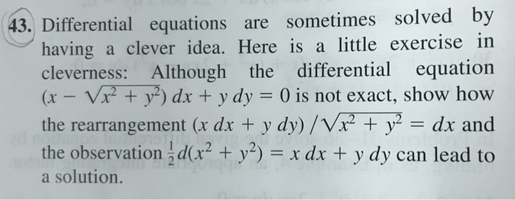Hi all,
I am totally stuck on an exercise in the differential equation book from Zill. I even have the solution but I just don't understand it. It is in the section about exact differential equations.
It goes like this:
"Differential equations are sometimes solved by having a clever idea. Here is a little exercise in cleverness. Although the differential equation
[imath]\left(x - \sqrt{x^2 + y^2}\right) dx + y\, dy = 0[/imath] is not exact, show how the rearrangement [imath]\frac{x\,dx + y\, dy}{\sqrt{x^2 + y^2}} = dx[/imath] and the observation [imath]\left(\frac{1}{2}\right)\,d(x^2 + y^2) = x\, dx + y\, dy[/imath] can lead to a solution."
I am totally stuck on this exercise. From the first equation, I can rearrange it just fine, but then I am just stuck.
What is even worse is that I have the solution book but I just can't follow it.
It states:
"First note that [imath]d(x^2 + y^2) = \left(\frac{x}{\sqrt{x^2 + y^2}}\right)dx + \left(\frac{y}{\sqrt{x^2 + y^2}}\right)dy[/imath]"
I already have no clue how they come to this.
If I take this [imath]\left(\frac{1}{2}\right)\left(d(x^2 + y^2)\right) = x\, dx + y\, dy[/imath] and multiply both sides with [imath]2[/imath] and divide by [imath](x^2 + y^2)[/imath],
then I will get [imath]d\left(\sqrt{x^2 + y^2}\right) = \left(\frac{2x}{\sqrt{x^2 + y^2}}\right) dx + \left(\frac{2y}{\sqrt{x^2 + y^2}}\right) dy[/imath]
But that is already different than the book.
I am totally stuck on this problem with this problem and I was hoping someone could make it clearer to me.
I also don't really know what this means "[imath]\left(\frac{1}{2}\right)\, d(x^2 + y^2) = x\, dx + y\, dy[/imath]" I don't know what that d means (is that d(function)/dy?) and how they come to that solution.
Like you see I am totally stuck
I am totally stuck on an exercise in the differential equation book from Zill. I even have the solution but I just don't understand it. It is in the section about exact differential equations.
It goes like this:
"Differential equations are sometimes solved by having a clever idea. Here is a little exercise in cleverness. Although the differential equation
[imath]\left(x - \sqrt{x^2 + y^2}\right) dx + y\, dy = 0[/imath] is not exact, show how the rearrangement [imath]\frac{x\,dx + y\, dy}{\sqrt{x^2 + y^2}} = dx[/imath] and the observation [imath]\left(\frac{1}{2}\right)\,d(x^2 + y^2) = x\, dx + y\, dy[/imath] can lead to a solution."
I am totally stuck on this exercise. From the first equation, I can rearrange it just fine, but then I am just stuck.
What is even worse is that I have the solution book but I just can't follow it.
It states:
"First note that [imath]d(x^2 + y^2) = \left(\frac{x}{\sqrt{x^2 + y^2}}\right)dx + \left(\frac{y}{\sqrt{x^2 + y^2}}\right)dy[/imath]"
I already have no clue how they come to this.
If I take this [imath]\left(\frac{1}{2}\right)\left(d(x^2 + y^2)\right) = x\, dx + y\, dy[/imath] and multiply both sides with [imath]2[/imath] and divide by [imath](x^2 + y^2)[/imath],
then I will get [imath]d\left(\sqrt{x^2 + y^2}\right) = \left(\frac{2x}{\sqrt{x^2 + y^2}}\right) dx + \left(\frac{2y}{\sqrt{x^2 + y^2}}\right) dy[/imath]
But that is already different than the book.
I am totally stuck on this problem with this problem and I was hoping someone could make it clearer to me.
I also don't really know what this means "[imath]\left(\frac{1}{2}\right)\, d(x^2 + y^2) = x\, dx + y\, dy[/imath]" I don't know what that d means (is that d(function)/dy?) and how they come to that solution.
Like you see I am totally stuck
Last edited by a moderator:

